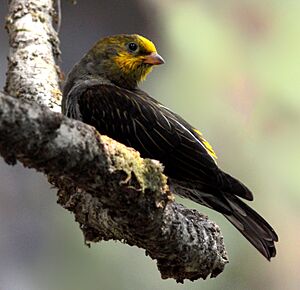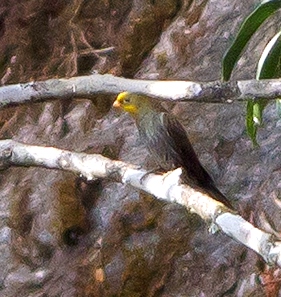Yellow-rumped honeyguide facts for kids
Quick facts for kids Yellow-rumped honeyguide |
|
|---|---|
 |
|
| From Eaglenest Wildlife Sanctuary in Arunachal Pradesh, India | |
| Conservation status | |
| Scientific classification | |
| Genus: |
Indicator
|
| Species: |
xanthonotus
|
The yellow-rumped honeyguide (Indicator xanthonotus) is a small bird, about the size of a sparrow. It belongs to the honeyguide family and lives in Asia, mostly in mountain forests along the Himalayas.
These birds look a lot like finches. They have strong feet with two toes pointing forward and two pointing backward. This special foot shape helps them hold onto things. Yellow-rumped honeyguides often perch on honeycombs and eat wax.
Male honeyguides usually stay in one area, protecting their territory near honeycombs. Females and young birds travel more widely to find food. These birds are also brood parasites. This means they lay their eggs in the nests of other birds, like barbets, and let the other birds raise their chicks.
Contents
What Does the Yellow-Rumped Honeyguide Look Like?

The yellow-rumped honeyguide is a small bird with a strong, finch-like beak. Its feathers are mostly a dull olive color. The front of its head and the area around its eyes are orange.
Its back and rump are a bright orange, which fades into a sulfur yellow color. The chin and throat are yellowish, and the belly is pale gray with dark stripes. The beak is yellow but gets darker at the tip.
Female yellow-rumped honeyguides have less yellow on their faces. Their rump is yellow, but it doesn't have the orange color seen in males. These birds have twelve tail feathers and nine main wing feathers. Their wings are long and pointed, which helps them fly.
How Do Yellow-Rumped Honeyguides Behave?
When flying or feeling upset, these birds make a chipping sound. They fly in a straight line, sometimes in groups of 20 to 30 birds. When they find an old honeycomb, they hold on tightly and press their tail against it.
They mostly eat the wax that holds the combs of Apis laboriosa bees to rocks. They can even feed on active beehives without bothering the bees too much. Sometimes, they use the attacks of large wasps, Vespa mandarinia, on bee colonies to their advantage.
Mating and Reproduction
Males have a special display to attract females. They fluff up their feathers, hold their beak high, and flick their wings while swaying. A female might flick her tail and press it down with drooped wings before a male mates with her.
As brood parasites, they lay their eggs in the nests of other bird species. We don't know exactly which birds are their hosts yet. Young honeyguide chicks have special hooks on their beaks. They use these hooks to destroy the eggs or chicks of the host bird.
Male honeyguides often control areas around beehives. They can mate with several females, a system called polygyny. They allow the females they've mated with, and their young, to enter their territory.
Unlike other honeyguides, this species has not been seen leading humans or bears to beehives.
Where Do Yellow-Rumped Honeyguides Live?
These birds have been seen in northern Pakistan, but they might not live there anymore. They are found in the Himalayan regions of India, including Uttar Pradesh, Himachal Pradesh, Nepal, Sikkim, Arunachal Pradesh, and Bhutan. They are quite common in Bhutan.
You can also find them in southeastern Tibet and northern Myanmar. They live in forests with pine trees and dry-deciduous trees, especially where there are rocky cliffs. They might move to different altitudes depending on the season.



